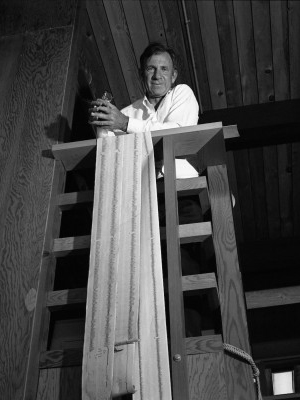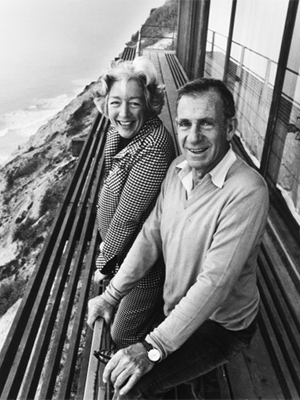Scripps Institution of Oceanography at the University of California San Diego has nominated the Munk Laboratory, a post-and-beam structure at the center of its oceanfront campus, for inclusion in the National Register of Historic Places.
Nominators cite the redwood building’s organic character and mid-century modern post-and-beam style but also its significance as a locale at which history-making scientific discoveries took place. The building, completed in 1963, is named for iconic geophysicist Walter Munk, who was the first leader of the Institute of Geophysics and Planetary Physics (IGPP) center in La Jolla. Munk made fundamental observations of ocean waves, tidal forces, and acoustic properties that have influenced generations of scientists. Other researchers made significant contributions to plate tectonics theory working in the IGPP complex while still others created the first digital seismograph and ocean-bottom seismograph there.

North entrance to the Munk Laboratory. Photo: Darren Bradley
Carmen Pauli, an architect with San Diego’s Heritage Architecture and Planning, said the push for historic designation began last year when her firm oversaw renovations to the complex. The building, she said, is special not just because of its association with Munk but also with its architect Lloyd Ruocco, one of the most prominent in San Diego in the mid-20th century. Other Ruocco buildings include the Design Center in the Bankers Hill neighborhood of San Diego, built in 1949. The Modern post-and-beam design, materials, and workmanship remain intact to date, exemplified through the redwood exterior, flat roof with overhanging eaves, and floor-to-ceiling windows and sliding glass doors.
Ruocco “is one of the most important figures in the modern movement in San Diego,” said Pauli. “This is maybe his number one or two most important buildings ever.”
The designation request comes before the California State Office of Preservation on July 30 and advocates encourage members of the Scripps community and interested public to submit letters of support. If the state entity approves the request, it will forward it to the National Park Service and recommend the building be added to the National Register of Historic Places. The designation would enable the building to be considered eligible for various infrastructure grants, Pauli said.
Camilla Ingram, director of Capital Programs and Space Management at Scripps Oceanography, and Wayne Farquharson, management service officer for IGPP, lead the nomination effort.
"The Munk Laboratory embodies multiple unique design features that stand out from other scientific buildings of the time and help inspire design in new buildings,” said Ingram. “As such, it should be nationally recognized.”


The view from the Munk Laboratory conference room and offices. Photos: Darren Bradley
The building was the first manifestation at Scripps Oceanography of the Institute for Geophysics, a research entity conceived in the final days of World War II and based initially at UCLA. Scripps Oceanography had been affiliated with UCLA prior to the creation of UC San Diego in 1960. Scripps Oceanography Director Roger Revelle gave Munk the opportunity to create the branch from the ground up and serve as its first director in large part to counter offers Munk was receiving from Harvard and MIT to join their faculties.
Texas Instruments founder Cecil Green contributed funds to build the lab, which was completed in 1963. Ruocco, whose mantra was that “good architecture should call for the minimum use of materials for the most interesting and functional enclosure of space,” was selected as the architect. Munk’s wife, Judith, herself a trained architect, collaborated with him in planning the building’s layout.
The upper part of the building is oriented east-west and juts out to the edge of the bluff providing dramatic ocean views of Scripps Pier and the Pacific Ocean. The naturally sloped topography of the site allows for exterior access to all levels of the building. The lower laboratory wing also features tall sliding glass doors with access to loading areas which have enabled large oceanographic and acoustic equipment to be loaded from labs to ships with ease.
A landscape created by the firm Harriet Wimmer and Joseph Yamada surrounds the building and shares the lab’s aesthetic of integration into a surrounding environment. Their design features mature melaleuca trees, and pittosporum and juniper shrubs among the walkways, and small secluded gardens for contemplation. Green had the sculpture Spring Stirring by artist Donal Hord purchased and moved to a location just north of the lab.


Left: Aerial view of the Munk Laboratory, 1969. Right: Sculptor Donal Hord, Ida and Cecil Green, and Judith Munk at Spring Stirring sculpture, 1963. Photos: UC Regents
Walter Munk’s vision for the lab was to be a place for study of geophysics in its broadest sense, taking the holistic view of the field that his mentor and former Scripps Director Harald Sverdrup had taken of oceanography years earlier. Soon after its founding, though, its scope was expanded even further – and the name of the institute changed – to include planetary physics when astronomers Geoffrey and Margaret Burbridge took up residence in the lab temporarily after joining UC San Diego.
“Even a lowly postdoc like me had a lovely office with a great ocean view on the top floor; students, too, had offices just as fine as those of eminent faculty like John Miles and Carl Eckart,” said Robert Parker, an emeritus professor of geophysics who had served as head of IGPP. “In the late ‘60s, when I arrived, there were physics faculty like Margaret and Geoffrey Burbidge, on the top floor too, as Urey Hall was still under construction. Geoffrey would call for his wife in a loud voice when he had an idea he wanted to discuss with her. It was a lively place.”

While at IGPP, Parker and colleagues such as geophysicists George Backus and Freeman Gilbert created what is known as inverse theory, which applied mathematical models to describe concepts like the elasticity and density of Earth’s mantle and core. Fellow IGPP geophysicist David Sandwell created the methodology to map the ocean seafloor through gravity measurements. The result is now the basis of seafloor representations seen on computer applications such as Google Earth.
In the 1990s, the university created a complementary edifice known as the Revelle Lab, which is adjacent to the Munk Lab separated by the road Biological Grade. The addition replicates the construction style of the original building in terms of materials and design.
The spirit of the Munk Lab is manifested in subtle ways. Instead of assigning office numbers, each office in the building is identified by a photo of a scientist who had made contributions to geophysics. Doors feature snapshots of people like Edwin Hubble, namesake of the Hubble Space Telescope, and John von Neumann, a Manhattan Project scientist who had, among other things, introduced the term ‘kiloton’ to quantify the size of nuclear explosions. Munk’s own door was identified by a portrait of ocean circulation pioneer Herbert Stommel.


The halls and decks of the Munk Laboratory, 2021. Photos: Darren Bradley
In the Munk Lab conference rooms, several pieces of original furniture were custom-designed by Ruocco specifically for the space, including a modular curved chalkboard and modular two-section curved conference table. Munk had the initial idea to make a chalkboard in the conference room long enough to fit an entire lecture, and Ruocco suggested curving it around the room. Tapa cloths collected by Munk and Revelle in Tonga during the 1952-53 Capricorn Expedition, in which Scripps Oceanography researchers studied a broad expanse of the Pacific Ocean, hang on the walls to provide sound insulation but also as a nod to Scripps history.

Munk Laboratory conference room, 1966. Walter Munk center right. Photo: Sweeney/Rubin Ansel Adams Fiat Lux Collection
Ingram said the influence of Judith Munk, “who understood how scientists worked and how to enhance their efforts,” can be seen in design touches such as built-in bookcases throughout and the addition of common spaces between offices to make interactions among scientists easier. Large sliding glass doors and plate glass windows accentuate building occupants’ sense of connection with the surrounding environment. The atmosphere of the building is intended to convey a warmth and humanity uncommon for laboratory settings.

“We thought it should be more like a home than a hall,” Walter Munk said in an interview in 1997. “More flexible. And the choice of redwood is connected to that. We chose Lloyd Ruocco. He’d never done a laboratory building. We thought that was a great asset.”
“The primary concept of the building was to encourage collaboration between the faculty, scientific staff and graduate students,” said Ingram. “To accomplish this, many offices, both faculty and staff, are on a mezzanine above the assembly laboratories, conference rooms and meeting areas are strategically placed. The circulation patterns encourage chance meetings, and there is an overall feeling of openness that takes advantage of the stunning site.”
Letters in support of the historic designation can be sent via mail to Julianne Polanco, State Historic Preservation Officer (SHPO), Office of Historic Preservation, 1725 23rd Street, Suite 100, Sacramento, Calif. 95816 or via email at info.calshpo@parks.ca.gov.